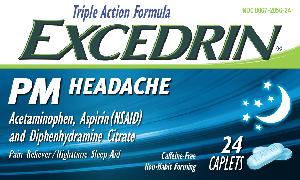Excedrin PM Headache Interactions
There are 817 drugs known to interact with Excedrin PM Headache (acetaminophen / aspirin / diphenhydramine), along with 20 disease interactions, and 3 alcohol/food interactions. Of the total drug interactions, 82 are major, 707 are moderate, and 28 are minor.
- View all 817 medications that may interact with Excedrin PM Headache
- View Excedrin PM Headache alcohol/food interactions (3)
- View Excedrin PM Headache disease interactions (20)
Most frequently checked interactions
View interaction reports for Excedrin PM Headache (acetaminophen / aspirin / diphenhydramine) and the medicines listed below.
- amitriptyline
- amoxicillin
- Benadryl (diphenhydramine)
- biotin
- buspirone
- Celebrex (celecoxib)
- cetirizine
- cyclobenzaprine
- diazepam
- doxycycline
- doxylamine
- Excedrin Migraine (acetaminophen / aspirin / caffeine)
- Flexeril (cyclobenzaprine)
- gabapentin
- hydrocodone
- ibuprofen
- levothyroxine
- Lexapro (escitalopram)
- losartan
- magnesium citrate
- magnesium glycinate
- melatonin
- meloxicam
- methylprednisolone
- omeprazole
- prednisone
- sumatriptan
- trazodone
- Vitamin D3 (cholecalciferol)
- Zyrtec (cetirizine)
Excedrin PM Headache alcohol/food interactions
There are 3 alcohol/food interactions with Excedrin PM Headache (acetaminophen / aspirin / diphenhydramine).
Excedrin PM Headache disease interactions
There are 20 disease interactions with Excedrin PM Headache (acetaminophen / aspirin / diphenhydramine) which include:
- alcoholism
- liver disease
- depression
- coagulation
- asthma
- GI toxicity
- renal dysfunction
- Reye's syndrome
- PKU
- anticholinergic effects
- asthma/COPD
- cardiovascular
- renal/liver disease
- glaucoma
- liver disease
- resp depression
- anemia
- dialysis
- G-6-PD deficiency
- hepatotoxicity
Drug Interaction Classification
| Highly clinically significant. Avoid combinations; the risk of the interaction outweighs the benefit. | |
| Moderately clinically significant. Usually avoid combinations; use it only under special circumstances. | |
| Minimally clinically significant. Minimize risk; assess risk and consider an alternative drug, take steps to circumvent the interaction risk and/or institute a monitoring plan. | |
| No interaction information available. |
See also:
Further information
Always consult your healthcare provider to ensure the information displayed on this page applies to your personal circumstances.


